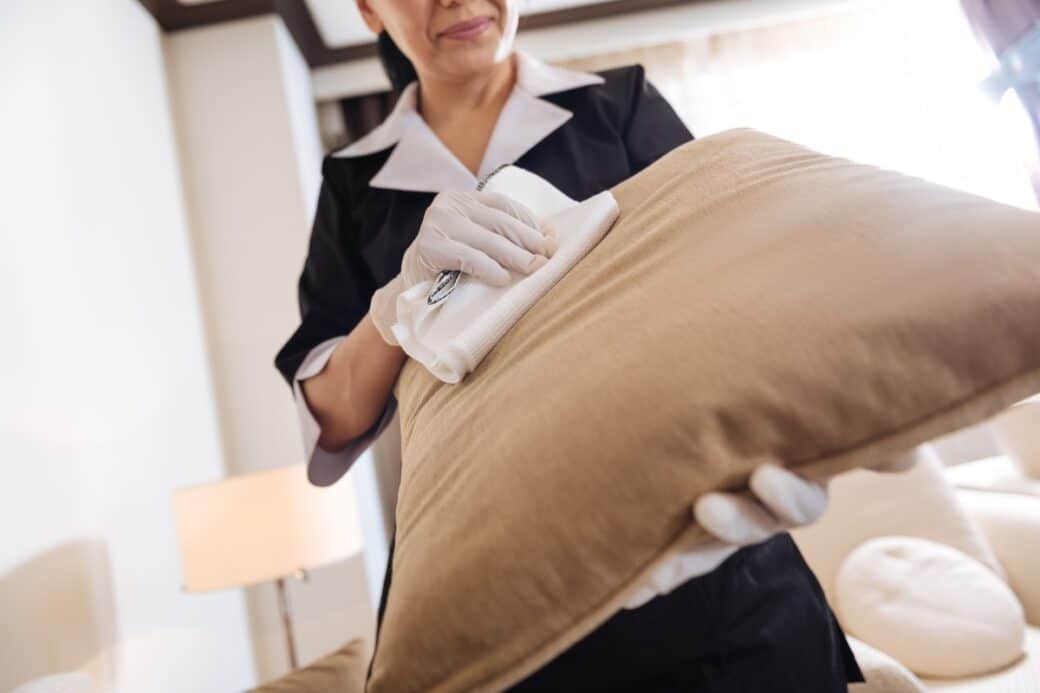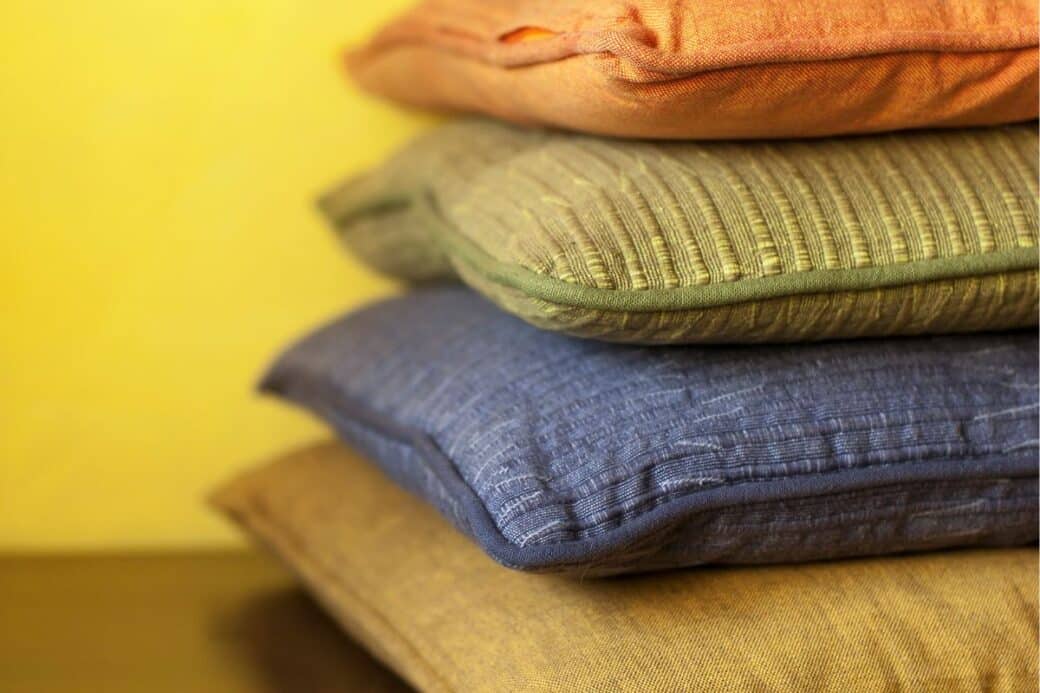Maintaining a clean and hygienic meditation cushion is essential for a blissful meditation practice. With regular use, your cushion can gather dust, sweat, and even unpleasant odors. However, fear not, as keeping your meditation cushion clean is a simple task that can be easily incorporated into your cleaning routine. In this article, you will discover the step-by-step process of how to effectively clean your meditation cushion, ensuring a fresh and inviting space for your daily meditation practice. Say goodbye to distractions and hello to a serene and sanitary meditation experience.

How To Clean Meditation Cushion: Understanding the Importance of Cleaning a Meditation Cushion
The need for maintaining hygiene when meditating
When it comes to meditation, maintaining cleanliness and hygiene is essential. Meditation is a practice that requires stillness, focus, and a clear mind. A dirty or unclean meditation cushion can not only be distracting but can also disrupt the peaceful and calming atmosphere required for effective meditation. A clean and well-maintained cushion not only adds to the overall ambiance of the space but also creates a more pleasant and comfortable experience for the meditator.
Understanding the connection between cleanliness and positive energy
Cleanliness has long been associated with positive energy and a sense of well-being. In the context of meditation, this becomes even more significant. A clean meditation cushion can help in creating a sacred and pure space for your practice. It sets the tone for the session by allowing positive energy to flow freely and unhampered. By cleaning your meditation cushion regularly, you are not only ensuring physical cleanliness but also fostering a clean and positive energy environment for your meditation.
The impact of a clean meditation space on focus and concentration
Meditation requires a high level of focus and concentration. A cluttered and dirty space can hamper these qualities, making it difficult to fully engage in the practice. By keeping your meditation cushion clean, you create an environment that promotes focus and concentration. A clean space allows for clearer thinking and the ability to let go of external distractions. By investing time and effort into maintaining the cleanliness of your meditation cushion, you are setting yourself up for a successful and fulfilling meditation practice.
Recognizing the Types of Meditation Cushions
Understanding the different materials used in meditation cushions
Meditation cushions come in a variety of materials, each with its own unique properties and care requirements. Common materials used for meditation cushions include cotton, hemp, silk, and microfiber. Understanding the material of your cushion is crucial in determining the appropriate cleaning methods and products to use. Some materials may require special care, such as handwashing or specific cleaning solutions, while others may be easily washable in a machine.
Specific cleaning methods for each type
Different materials require different cleaning methods. For cotton or hemp cushions, machine washing with a gentle detergent and air-drying is often suitable. Silk cushions may require more delicate care, such as handwashing or dry cleaning. Microfiber cushions can usually be machine washed, but it is important to avoid using fabric softener as it can reduce the cushion’s grip. Familiarize yourself with the specific cleaning instructions for your cushion to ensure its longevity and cleanliness.
Distinguishing easily-washable cushions from those requiring special care
While some meditation cushions can simply be thrown in the washing machine for a quick clean, others may require more specialized care. It is essential to determine which category your cushion falls into to avoid damaging it during the cleaning process. Additionally, some cushions may have removable covers that are easily washable, while others may require spot cleaning or professional cleaning services. Taking the time to understand the care requirements of your cushion will help you maintain its cleanliness without compromising its integrity.

Prevention is Better than Cure: Keeping Your Cushion Clean
Establishing a routine for meditation cushion cleaning
One of the best ways to keep your meditation cushion clean is to establish a regular cleaning routine. Set aside specific days or times dedicated to cleaning and maintaining your cushion. This could include a thorough dusting, spot cleaning any stains or spills, and refreshing the cushion’s scent. By incorporating these tasks into your regular routine, you ensure that your cushion remains clean and fresh, ready for your daily meditation practice.
Preventing spills and stains on your meditation cushion
Prevention is key when it comes to dealing with spills and stains on your meditation cushion. Accidents can happen, but by taking some precautions, you can minimize the potential for stains and spills. Always remove any food or drinks from the meditation space before beginning your practice. If you prefer to have a drink nearby, consider using a spill-proof container. Additionally, placing a cloth or towel on your cushion can help protect it from any unexpected spills or stains.
The role of cushion covers in maintaining cleanliness
Cushion covers play a significant role in maintaining the cleanliness of your meditation cushion. They act as a barrier, protecting the cushion from direct contact with dirt, sweat, and other substances. Many cushion covers are easily removable and can be machine washed or hand washed separately from the cushion itself. By regularly washing and changing your cushion cover, you can ensure that your meditation cushion remains clean and hygienic.
Dusting off the Meditation Cushion
How to properly dust off a meditation cushion
Regular dusting is essential in keeping your meditation cushion clean and free from dirt and debris. To properly dust off your cushion, start by removing any removable covers and set them aside for cleaning. Use a soft-bristle brush or a vacuum cleaner with a brush attachment to gently remove any dust or particles from the cushion. Be sure to pay attention to the crevices and corners to ensure a thorough cleaning.
Frequency of dusting required for meditation cushions
The frequency of dusting your meditation cushion will depend on various factors, including the environment in which it is used and personal preferences. As a general guideline, it is recommended to dust off your cushion at least once a week. However, if you meditate in an area prone to dust or if you notice accumulation on your cushion, more frequent dusting may be necessary. Regular dusting will help maintain the cleanliness of your cushion and prevent the buildup of dust and allergens.
Different tools for dusting off meditation cushions
There are several tools you can use to effectively dust off your meditation cushion. A soft-bristle brush or a brush attachment on a vacuum cleaner are common options. These tools allow you to gently remove dust without damaging the cushion’s material. Alternatively, a lint roller or a microfiber cloth can also be used to pick up dust and debris. Choose a tool that is suitable for your cushion’s material and use it regularly to keep your cushion clean and dust-free.
Spot Cleaning Stains and Spills
Identifying the type of stain or spill on your cushion
When it comes to stain and spill removal, it is important to first identify the type of stain or spill on your meditation cushion. Different substances may require different cleaning solutions and techniques. Common stains include food and drink spills, sweat marks, and dirt stains. By determining the type of stain, you can effectively address it using the appropriate cleaning methods.
Creating natural, home-made cleaning solutions for spot cleaning
Natural, home-made cleaning solutions can be an effective and eco-friendly way to spot clean your meditation cushion. For food and drink stains, a mixture of mild dish soap and water can often do the trick. Sweat stains can be treated with a solution of white vinegar and water. When dealing with dirt stains, a paste made from baking soda and water can help lift the stain. Always test any cleaning solution on a small, inconspicuous area of the cushion before applying it to the stain.
The right technique for spot cleaning stains without spreading them
When spot cleaning stains on your meditation cushion, it is important to use the right technique to avoid spreading the stain or damaging the cushion. Start by gently blotting the stain with a clean cloth or sponge, working from the outside in to prevent the stain from spreading outward. Avoid rubbing or scrubbing the cushion, as this can push the stain deeper into the material. Once the stain has been treated, rinse the area with clean water and blot dry with a towel.
Deep Cleaning Your Meditation Cushion
When and why deep cleaning is necessary
While regular dusting and spot cleaning can help maintain the cleanliness of your meditation cushion, deep cleaning is necessary from time to time. Deep cleaning removes any deep-seated dirt, allergens, or odors that may have accumulated over time. It is especially important to deep clean your cushion if it has been subjected to heavy use or if you have noticed a persistent odor. Deep cleaning not only refreshes your cushion but also ensures a hygienic meditation space.
Step-by-step guide to deep-cleaning a meditation cushion
Deep-cleaning your meditation cushion requires a systematic approach to ensure thorough cleaning. Start by removing any removable covers and set them aside for cleaning. Depending on the material, either machine wash the cover using a gentle detergent or hand wash it separately. For the cushion itself, follow the specific cleaning instructions for your material. This may involve machine washing, handwashing, or spot cleaning, depending on the cushion’s care requirements. After cleaning, be sure to thoroughly dry the cushion before using it again.
Ensuring that the cushion is thoroughly dried post-cleaning
Proper drying is crucial after deep-cleaning your meditation cushion to avoid the growth of mold or mildew. Before using your cushion again, ensure that it is thoroughly dried. If your cushion is machine washable, set the machine to a gentle spin cycle to remove excess moisture. For hand-washed cushions, gently squeeze out the water and place the cushion in a well-ventilated area to air dry completely. Avoid direct sunlight or high heat, as this can damage the cushion’s material.
Addressing Germs and Bacteria
Understanding how meditation cushions can harbor germs and bacteria
Meditation cushions, like any other surface, can harbor germs and bacteria if not properly cleaned and maintained. Sweat, dead skin cells, and other bodily fluids can accumulate on the cushion over time, creating an ideal environment for bacterial growth. This can potentially cause odors, infections, or other health issues if not addressed. By regularly cleaning and disinfecting your cushion, you can significantly reduce the presence of germs and bacteria, ensuring a hygienic meditation practice.
Safe and effective disinfection methods for meditation cushions
Disinfecting your meditation cushion is an essential step in maintaining its cleanliness and hygiene. Safe and effective disinfection methods include using isopropyl alcohol or a mild bleach solution. Dilute the bleach in water as per the manufacturer’s instructions and use a cloth or spray bottle to apply the solution to the cushion. Allow the disinfectant to sit for a few minutes before rinsing with clean water. Be sure to thoroughly dry the cushion before use.
Utilizing UV sanitization
Another effective method for addressing germs and bacteria on your meditation cushion is through UV sanitization. UV sanitization involves using ultraviolet light to kill bacteria, viruses, and other microorganisms. There are UV sanitizing devices specifically designed for use on cushions and other surfaces. Simply place the cushion inside the device and allow the UV light to do its job. This method is efficient and chemical-free, making it a safe and environmentally-friendly option for disinfecting your cushion.
Dealing with Odors
Identifying causes of bad odor in a meditation cushion
Odors can sometimes develop in meditation cushions, making it unpleasant to use and interfering with your practice. Several factors can contribute to bad odors, including sweat, mold or mildew growth, and the accumulation of dust and dirt. Identifying the cause of the odor is crucial in effectively eliminating it and preventing it from reoccurring. By addressing the root cause, you can ensure that your cushion remains odor-free and fresh.
Methods of eliminating odors from meditation cushions
To eliminate odors from your meditation cushion, it is important to target the underlying cause. For sweat-related odors, spot cleaning the affected area with a vinegar and water solution can help neutralize the smell. If mold or mildew is the culprit, deep-cleaning the cushion and ensuring proper drying is necessary. Additionally, regular dusting and routine maintenance can prevent odors caused by dust and dirt accumulation. By incorporating these methods into your cushion cleaning routine, you can effectively eliminate odors and maintain a pleasant meditation space.
Natural methods to keep your meditation cushion smelling fresh
If you prefer to use natural methods to keep your meditation cushion smelling fresh, there are several options available. Placing a small pouch of dried lavender or cedar chips near your cushion can help absorb odors and impart a pleasant smell. You can also lightly spritz the cushion with a mixture of water and a few drops of essential oils, such as lavender or eucalyptus. These natural methods not only keep your cushion smelling fresh but also enhance the overall ambiance of your meditation space.
Refreshing Your Meditation Cushion Regularly
Routine activities for refreshing your meditation cushion
Regularly refreshing your meditation cushion ensures that it remains clean, hygienic, and pleasant to use. Some routine activities you can incorporate for refreshing your cushion include regular dusting, spot cleaning any stains or spills, and airing out the cushion to remove any lingering odors. By consistently implementing these activities, you can maintain the freshness and cleanliness of your cushion, enhancing your overall meditation experience.
Understanding the benefits of a pleasant-smelling cushion for meditation
A pleasant-smelling cushion can greatly enhance your meditation experience. Smell is a powerful sense that can evoke emotions and trigger specific moods. By having a cushion that smells pleasant, you create a soothing and invigorating atmosphere for your practice. A pleasant scent can help you relax, focus, and enter a deeper state of meditation. By taking the time to refresh and add a pleasant fragrance to your cushion, you are enhancing the overall quality of your meditation sessions.
Natural methods to enhance the scent of your meditation cushion
If you prefer natural methods to enhance the scent of your meditation cushion, there are various options available. Using dried herbs or flowers, such as lavender or rose petals, you can create sachets or pouches to place near your cushion. Essential oils can also be used to add a pleasant fragrance. Simply dilute a few drops of your preferred essential oil with water and spray it lightly onto the cushion. Be mindful of any allergies or sensitivities and choose scents that are soothing and relaxing to you.
Maintaining Meditation Cushion Storage
Choosing the right storage spot for cleanliness preservation
Proper storage is essential for maintaining the cleanliness of your meditation cushion. Choose a storage spot that is clean, dry, and away from direct sunlight. Avoid storing your cushion in a damp or humid area, as this can promote mold or mildew growth. Ideal storage locations may include a dedicated shelf, a clean closet, or a storage bag specifically designed for meditation cushions. By selecting the right storage spot, you can protect your cushion from dust, dirt, and other potential contaminants.
Storing your cushion correctly to prevent dust accumulation
To prevent dust accumulation on your meditation cushion during storage, it is important to store it correctly. Remove any removable covers and wash them before storing to maintain their cleanliness. For the cushion itself, ensure that it is thoroughly dry before placing it in storage. Additionally, consider using a storage bag or cover to protect the cushion from any potential dust or dirt. By keeping your cushion properly stored, you can preserve its cleanliness and prolong its lifespan.
Proper air circulation to prevent mold and stale odors from developing
Proper air circulation is crucial in preventing the development of mold and stale odors in stored meditation cushions. Ensure that the storage area allows for adequate airflow to prevent any moisture buildup. Avoid storing your cushion in plastic bags or airtight containers, as this can trap moisture and create a breeding ground for mold and bacteria. If possible, periodically air out the cushion by taking it out of storage and allowing it to breathe before returning it to its designated storage spot. By maintaining proper air circulation, you can keep your cushion fresh and free from unwanted odors.




